CHEVROLET SUBURBAN 2011 10.G Owners Manual
Manufacturer: CHEVROLET, Model Year: 2011, Model line: SUBURBAN, Model: CHEVROLET SUBURBAN 2011 10.GPages: 542, PDF Size: 7.54 MB
Page 461 of 542
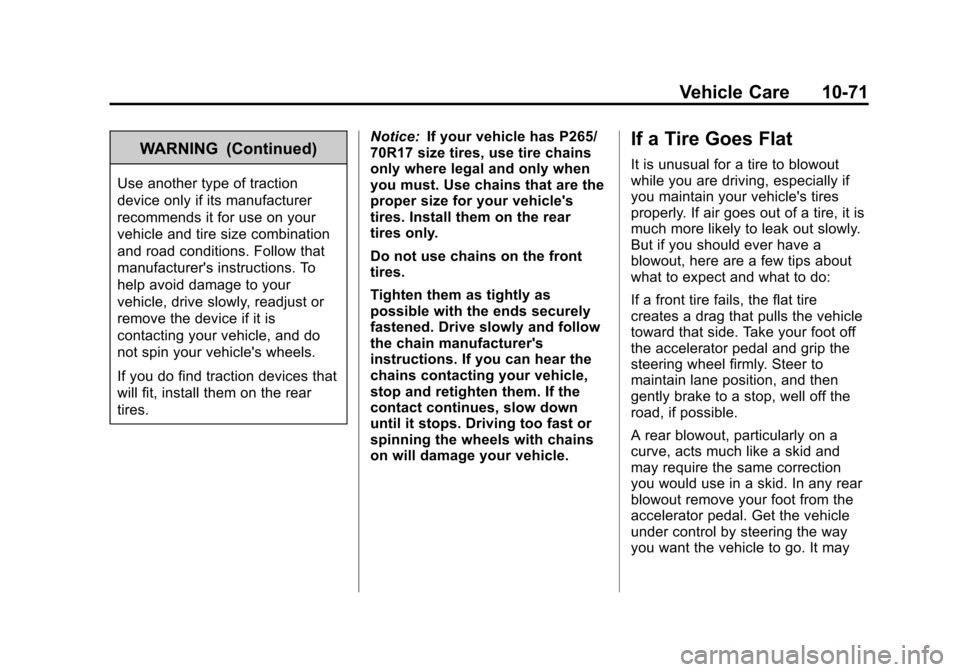
Black plate (71,1)Chevrolet Tahoe/Suburban Owner Manual - 2011
Vehicle Care 10-71
WARNING (Continued)
Use another type of traction
device only if its manufacturer
recommends it for use on your
vehicle and tire size combination
and road conditions. Follow that
manufacturer's instructions. To
help avoid damage to your
vehicle, drive slowly, readjust or
remove the device if it is
contacting your vehicle, and do
not spin your vehicle's wheels.
If you do find traction devices that
will fit, install them on the rear
tires.Notice:
If your vehicle has P265/
70R17 size tires, use tire chains
only where legal and only when
you must. Use chains that are the
proper size for your vehicle's
tires. Install them on the rear
tires only.
Do not use chains on the front
tires.
Tighten them as tightly as
possible with the ends securely
fastened. Drive slowly and follow
the chain manufacturer's
instructions. If you can hear the
chains contacting your vehicle,
stop and retighten them. If the
contact continues, slow down
until it stops. Driving too fast or
spinning the wheels with chains
on will damage your vehicle.
If a Tire Goes Flat
It is unusual for a tire to blowout
while you are driving, especially if
you maintain your vehicle's tires
properly. If air goes out of a tire, it is
much more likely to leak out slowly.
But if you should ever have a
blowout, here are a few tips about
what to expect and what to do:
If a front tire fails, the flat tire
creates a drag that pulls the vehicle
toward that side. Take your foot off
the accelerator pedal and grip the
steering wheel firmly. Steer to
maintain lane position, and then
gently brake to a stop, well off the
road, if possible.
A rear blowout, particularly on a
curve, acts much like a skid and
may require the same correction
you would use in a skid. In any rear
blowout remove your foot from the
accelerator pedal. Get the vehicle
under control by steering the way
you want the vehicle to go. It may
Page 462 of 542
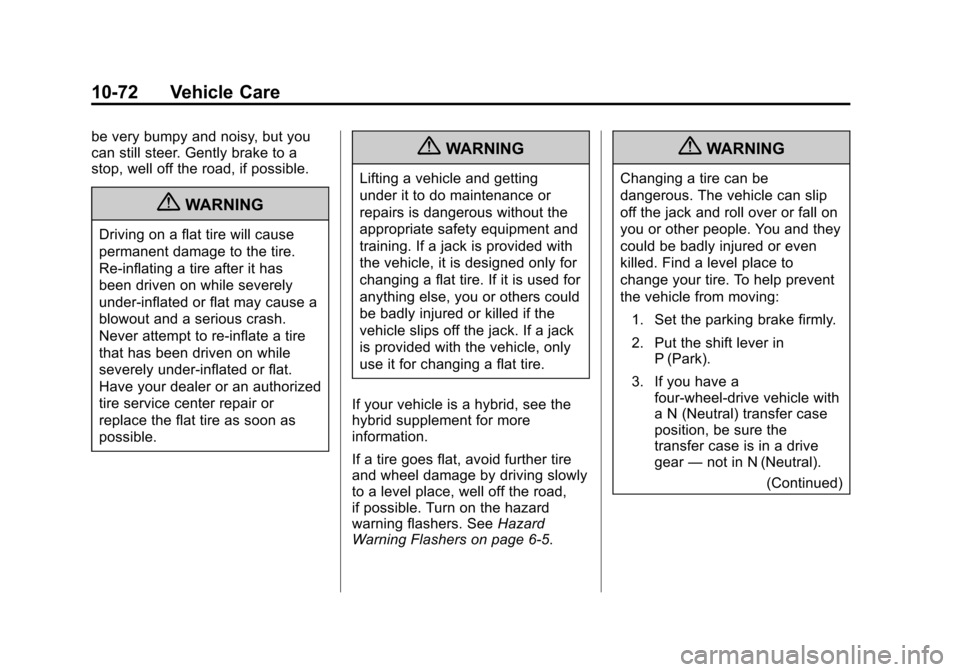
Black plate (72,1)Chevrolet Tahoe/Suburban Owner Manual - 2011
10-72 Vehicle Care
be very bumpy and noisy, but you
can still steer. Gently brake to a
stop, well off the road, if possible.
{WARNING
Driving on a flat tire will cause
permanent damage to the tire.
Re-inflating a tire after it has
been driven on while severely
under-inflated or flat may cause a
blowout and a serious crash.
Never attempt to re-inflate a tire
that has been driven on while
severely under-inflated or flat.
Have your dealer or an authorized
tire service center repair or
replace the flat tire as soon as
possible.
{WARNING
Lifting a vehicle and getting
under it to do maintenance or
repairs is dangerous without the
appropriate safety equipment and
training. If a jack is provided with
the vehicle, it is designed only for
changing a flat tire. If it is used for
anything else, you or others could
be badly injured or killed if the
vehicle slips off the jack. If a jack
is provided with the vehicle, only
use it for changing a flat tire.
If your vehicle is a hybrid, see the
hybrid supplement for more
information.
If a tire goes flat, avoid further tire
and wheel damage by driving slowly
to a level place, well off the road,
if possible. Turn on the hazard
warning flashers. See Hazard
Warning Flashers on page 6‑5.
{WARNING
Changing a tire can be
dangerous. The vehicle can slip
off the jack and roll over or fall on
you or other people. You and they
could be badly injured or even
killed. Find a level place to
change your tire. To help prevent
the vehicle from moving:
1. Set the parking brake firmly.
2. Put the shift lever in P (Park).
3. If you have a four-wheel-drive vehicle with
a N (Neutral) transfer case
position, be sure the
transfer case is in a drive
gear —not in N (Neutral).
(Continued)
Page 463 of 542
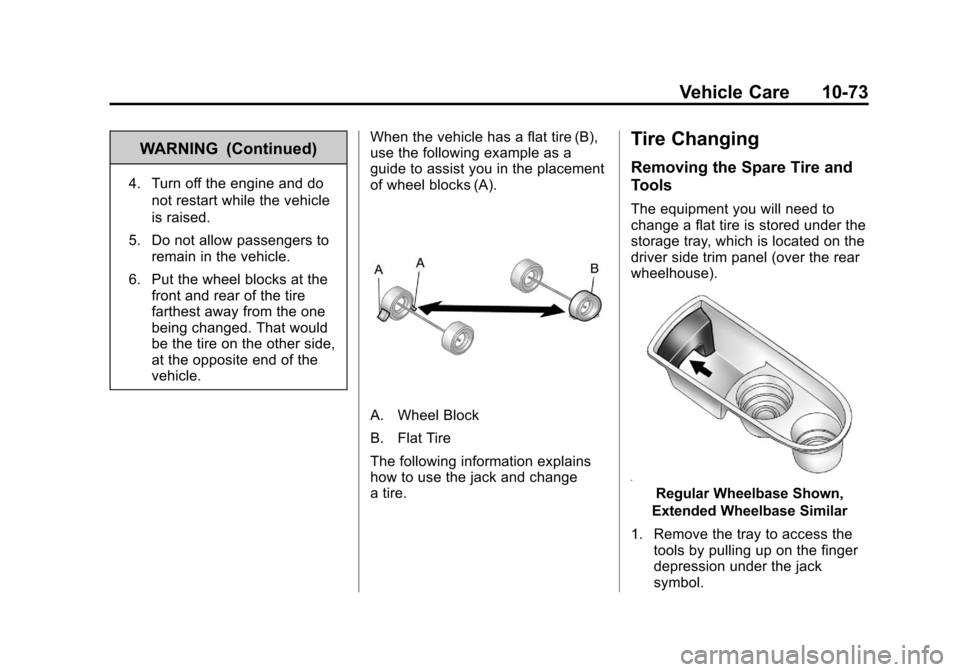
Black plate (73,1)Chevrolet Tahoe/Suburban Owner Manual - 2011
Vehicle Care 10-73
WARNING (Continued)
4. Turn off the engine and donot restart while the vehicle
is raised.
5. Do not allow passengers to remain in the vehicle.
6. Put the wheel blocks at the front and rear of the tire
farthest away from the one
being changed. That would
be the tire on the other side,
at the opposite end of the
vehicle. When the vehicle has a flat tire (B),
use the following example as a
guide to assist you in the placement
of wheel blocks (A).
A. Wheel Block
B. Flat Tire
The following information explains
how to use the jack and change
a tire.
Tire Changing
Removing the Spare Tire and
Tools
The equipment you will need to
change a flat tire is stored under the
storage tray, which is located on the
driver side trim panel (over the rear
wheelhouse).
Regular Wheelbase Shown,
Extended Wheelbase Similar
1. Remove the tray to access the tools by pulling up on the finger
depression under the jack
symbol.
Page 464 of 542
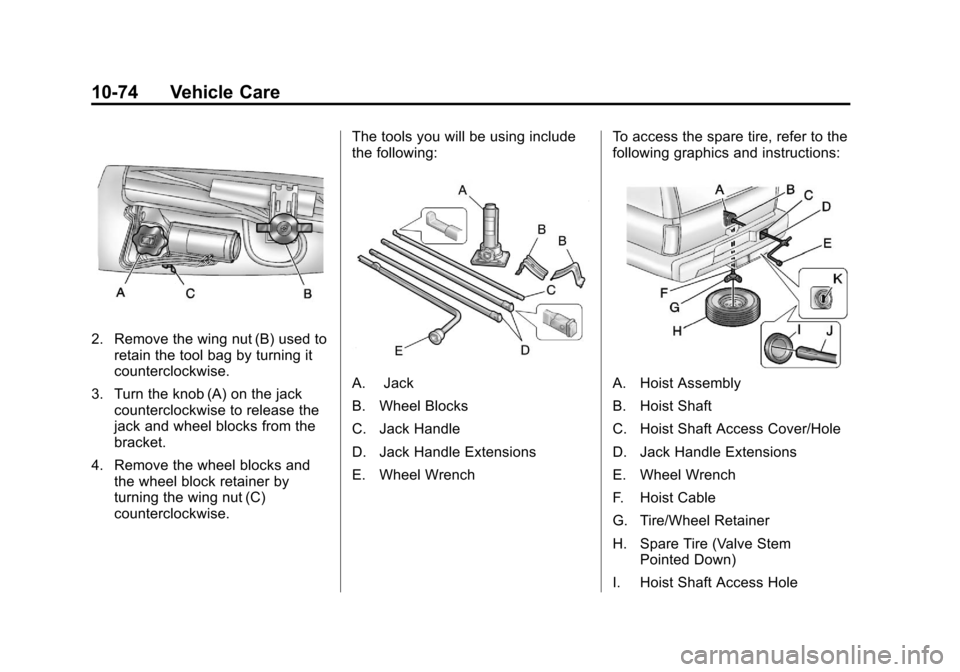
Black plate (74,1)Chevrolet Tahoe/Suburban Owner Manual - 2011
10-74 Vehicle Care
2. Remove the wing nut (B) used toretain the tool bag by turning it
counterclockwise.
3. Turn the knob (A) on the jack counterclockwise to release the
jack and wheel blocks from the
bracket.
4. Remove the wheel blocks and the wheel block retainer by
turning the wing nut (C)
counterclockwise. The tools you will be using include
the following:
A. Jack
B. Wheel Blocks
C. Jack Handle
D. Jack Handle Extensions
E. Wheel Wrench
To access the spare tire, refer to the
following graphics and instructions:A. Hoist Assembly
B. Hoist Shaft
C. Hoist Shaft Access Cover/Hole
D. Jack Handle Extensions
E. Wheel Wrench
F. Hoist Cable
G. Tire/Wheel Retainer
H. Spare Tire (Valve Stem
Pointed Down)
I. Hoist Shaft Access Hole
Page 465 of 542
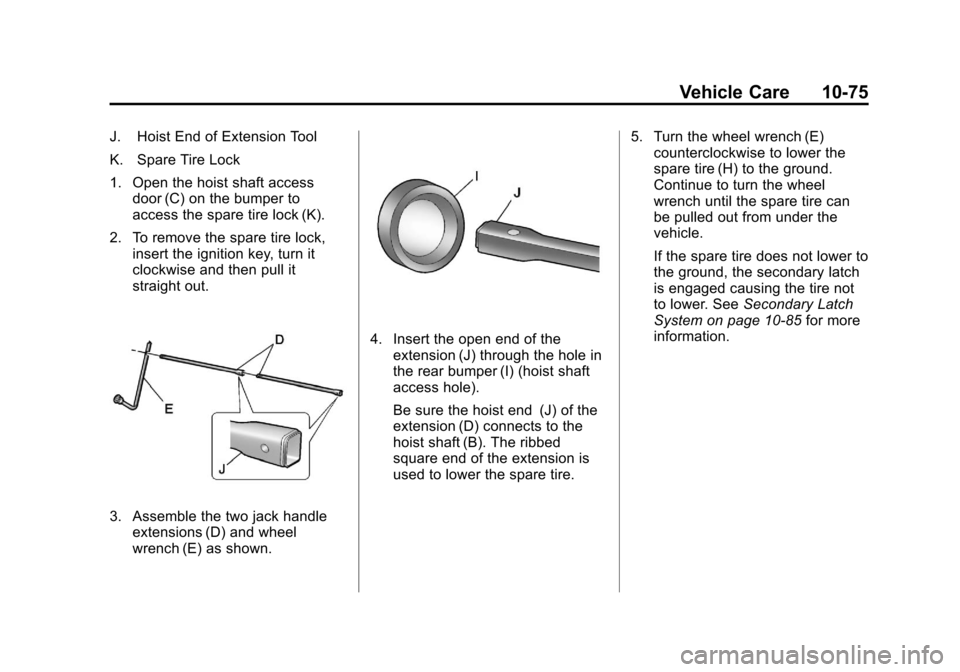
Black plate (75,1)Chevrolet Tahoe/Suburban Owner Manual - 2011
Vehicle Care 10-75
J. Hoist End of Extension Tool
K. Spare Tire Lock
1. Open the hoist shaft accessdoor (C) on the bumper to
access the spare tire lock (K).
2. To remove the spare tire lock, insert the ignition key, turn it
clockwise and then pull it
straight out.
3. Assemble the two jack handleextensions (D) and wheel
wrench (E) as shown.
4. Insert the open end of theextension (J) through the hole in
the rear bumper (I) (hoist shaft
access hole).
Be sure the hoist end (J) of the
extension (D) connects to the
hoist shaft (B). The ribbed
square end of the extension is
used to lower the spare tire. 5. Turn the wheel wrench (E)
counterclockwise to lower the
spare tire (H) to the ground.
Continue to turn the wheel
wrench until the spare tire can
be pulled out from under the
vehicle.
If the spare tire does not lower to
the ground, the secondary latch
is engaged causing the tire not
to lower. See Secondary Latch
System on page 10‑85 for more
information.
Page 466 of 542

Black plate (76,1)Chevrolet Tahoe/Suburban Owner Manual - 2011
10-76 Vehicle Care
6. Use the wheel wrench hook thatallows you to pull the hoist cable
towards you, to assist in
reaching the spare tire.7. Tilt the tire toward the vehiclewith some slack in the cable to
access the tire/wheel retainer.
Separate the retainer from the
guide pin by sliding the retainer
up the pin while pressing down
on the latch.Once the retainer is separated
from the guide pin, tilt the
retainer and pull it through the
center of the wheel along with
the cable and latch.
8. Put the spare tire near the flat tire.
Page 467 of 542
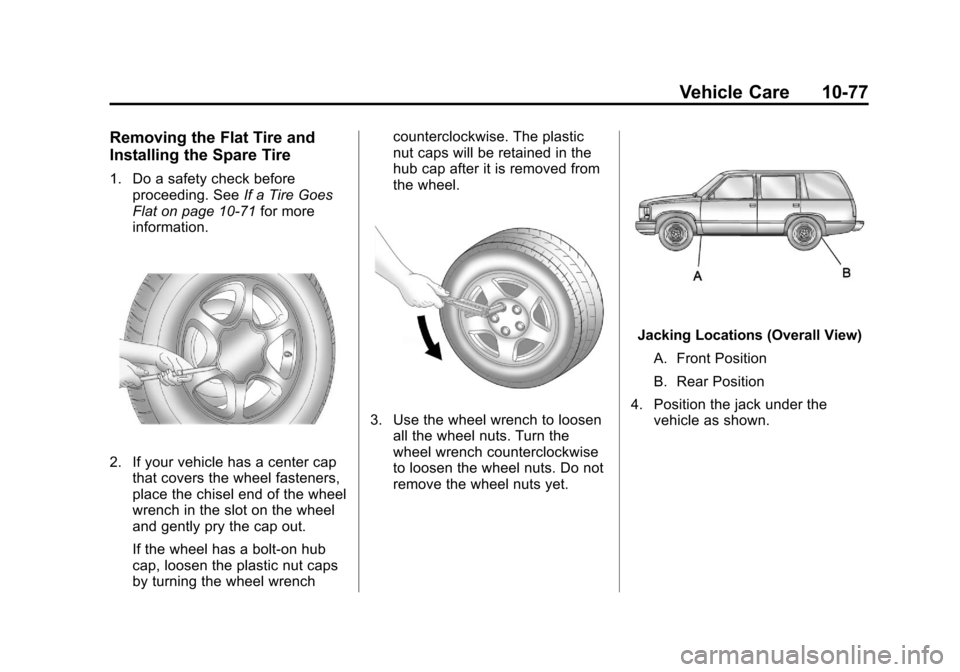
Black plate (77,1)Chevrolet Tahoe/Suburban Owner Manual - 2011
Vehicle Care 10-77
Removing the Flat Tire and
Installing the Spare Tire
1. Do a safety check beforeproceeding. See If a Tire Goes
Flat on page 10‑71 for more
information.
2. If your vehicle has a center cap that covers the wheel fasteners,
place the chisel end of the wheel
wrench in the slot on the wheel
and gently pry the cap out.
If the wheel has a bolt-on hub
cap, loosen the plastic nut caps
by turning the wheel wrench counterclockwise. The plastic
nut caps will be retained in the
hub cap after it is removed from
the wheel.
3. Use the wheel wrench to loosen
all the wheel nuts. Turn the
wheel wrench counterclockwise
to loosen the wheel nuts. Do not
remove the wheel nuts yet.
Jacking Locations (Overall View)
A. Front Position
B. Rear Position
4. Position the jack under the vehicle as shown.
Page 468 of 542
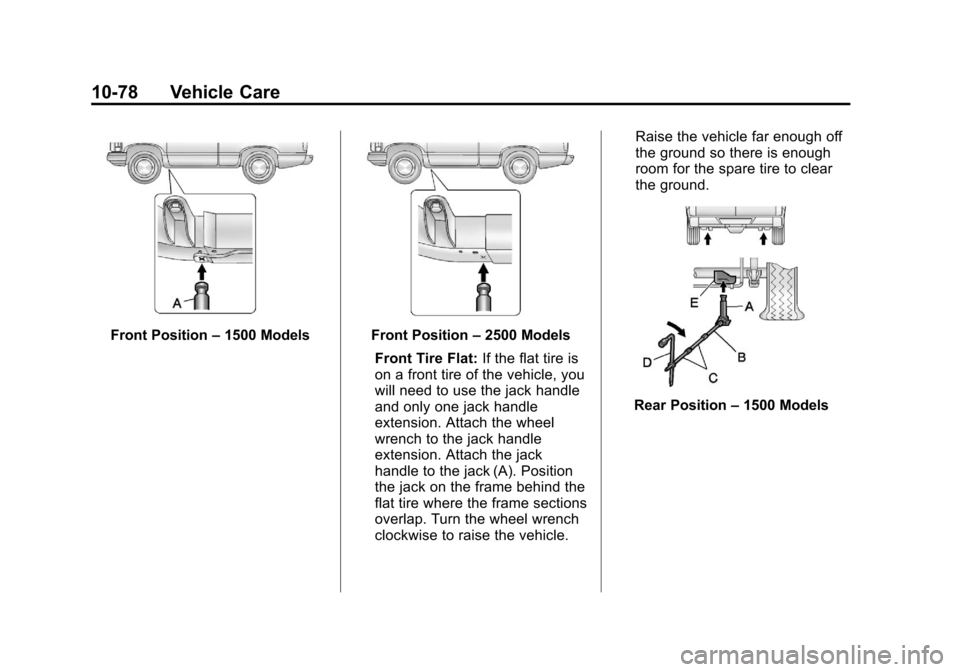
Black plate (78,1)Chevrolet Tahoe/Suburban Owner Manual - 2011
10-78 Vehicle Care
Front Position–1500 ModelsFront Position –2500 Models
Front Tire Flat: If the flat tire is
on a front tire of the vehicle, you
will need to use the jack handle
and only one jack handle
extension. Attach the wheel
wrench to the jack handle
extension. Attach the jack
handle to the jack (A). Position
the jack on the frame behind the
flat tire where the frame sections
overlap. Turn the wheel wrench
clockwise to raise the vehicle. Raise the vehicle far enough off
the ground so there is enough
room for the spare tire to clear
the ground.
Rear Position
–1500 Models
Page 469 of 542
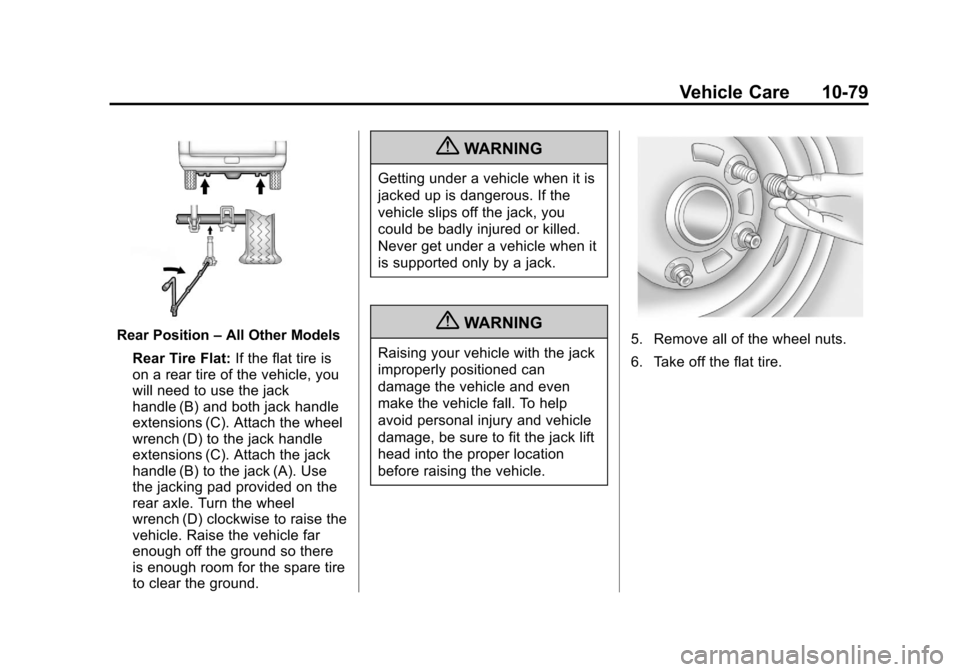
Black plate (79,1)Chevrolet Tahoe/Suburban Owner Manual - 2011
Vehicle Care 10-79
Rear Position–All Other Models
Rear Tire Flat: If the flat tire is
on a rear tire of the vehicle, you
will need to use the jack
handle (B) and both jack handle
extensions (C). Attach the wheel
wrench (D) to the jack handle
extensions (C). Attach the jack
handle (B) to the jack (A). Use
the jacking pad provided on the
rear axle. Turn the wheel
wrench (D) clockwise to raise the
vehicle. Raise the vehicle far
enough off the ground so there
is enough room for the spare tire
to clear the ground.
{WARNING
Getting under a vehicle when it is
jacked up is dangerous. If the
vehicle slips off the jack, you
could be badly injured or killed.
Never get under a vehicle when it
is supported only by a jack.
{WARNING
Raising your vehicle with the jack
improperly positioned can
damage the vehicle and even
make the vehicle fall. To help
avoid personal injury and vehicle
damage, be sure to fit the jack lift
head into the proper location
before raising the vehicle.5. Remove all of the wheel nuts.
6. Take off the flat tire.
Page 470 of 542
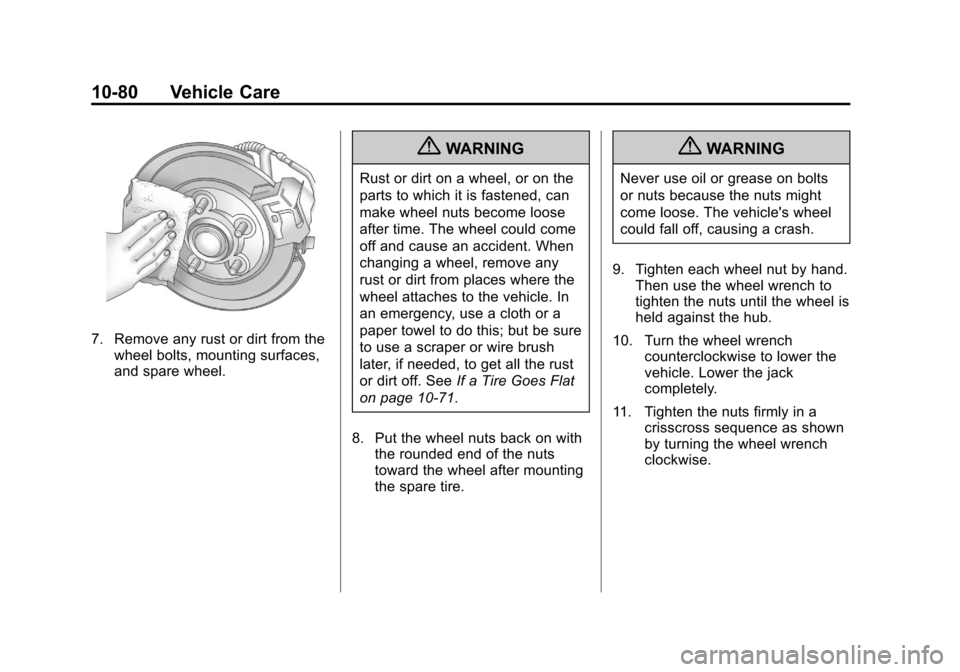
Black plate (80,1)Chevrolet Tahoe/Suburban Owner Manual - 2011
10-80 Vehicle Care
7. Remove any rust or dirt from thewheel bolts, mounting surfaces,
and spare wheel.
{WARNING
Rust or dirt on a wheel, or on the
parts to which it is fastened, can
make wheel nuts become loose
after time. The wheel could come
off and cause an accident. When
changing a wheel, remove any
rust or dirt from places where the
wheel attaches to the vehicle. In
an emergency, use a cloth or a
paper towel to do this; but be sure
to use a scraper or wire brush
later, if needed, to get all the rust
or dirt off. See If a Tire Goes Flat
on page 10‑71.
8. Put the wheel nuts back on with the rounded end of the nuts
toward the wheel after mounting
the spare tire.
{WARNING
Never use oil or grease on bolts
or nuts because the nuts might
come loose. The vehicle's wheel
could fall off, causing a crash.
9. Tighten each wheel nut by hand. Then use the wheel wrench to
tighten the nuts until the wheel is
held against the hub.
10. Turn the wheel wrench counterclockwise to lower the
vehicle. Lower the jack
completely.
11. Tighten the nuts firmly in a crisscross sequence as shown
by turning the wheel wrench
clockwise.